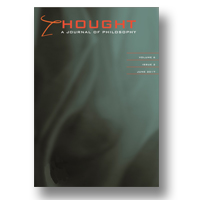|
issue information |
|
1.
|
Thought: A Journal of Philosophy:
Volume >
6 >
Issue: 1
Issue Information
view |
rights & permissions
| cited by
|
|
|
|
|
discussion notes |
|
2.
|
Thought: A Journal of Philosophy:
Volume >
6 >
Issue: 1
Friederike Moltmann
Attitude Reports, Cognitive Products, and Attitudinal Objects:
A Response to G. Felappi On Product-Based Accounts of Attitudes
abstract |
view |
rights & permissions
| cited by
In a range of recent and not so recent work (Moltmann 2003a, 2003b, 2004, 2013, 2014, 2016b, 2016d), I have developed a novel semantics of attitude reports on which the notion of an attitudinal object or cognitive product takes center stage, that is, entities such as thoughts claims and decisions. The purpose of this note is to give a brief summary of this account against the background of the standard semantics of attitude reports and to show that the various sorts of criticism that Felappi (2014) recently advanced against it are mistaken.
|
|
|
|
|
3.
|
Thought: A Journal of Philosophy:
Volume >
6 >
Issue: 1
Tomasz Wysocki
Explanatory Circles, Induction, and Recursive Structures
abstract |
view |
rights & permissions
| cited by
Lange (2009) offers an argument that, according to him, “does not show merely that some proofs by mathematical induction are not explanatory. It shows that none are […]” (p. 210). The aim here is to present a counterexample to his argument.
|
|
|
|
|
4.
|
Thought: A Journal of Philosophy:
Volume >
6 >
Issue: 1
Ryan Wasserman
Time Travel, Ability, and Arguments by Analogy
view |
rights & permissions
| cited by
|
|
|
|
|
original articles |
|
5.
|
Thought: A Journal of Philosophy:
Volume >
6 >
Issue: 1
Pablo Carnino
Grounding is Not Superinternal
abstract |
view |
rights & permissions
| cited by
Whenever a fact P grounds another fact Q, one may ask why that is so. Karen Bennett (2011) and Louis deRosset (2013) independently argue that grounding facts—such as the fact that P grounds Q—are always grounded in their grounds-part (what stands in P’s position). Bennett calls this the view that grounding is superinternal. My aim in this paper is to argue that grounding is not superinternal. I will do so by showing that superinternality, together with some widely accepted formal features of grounding—namely, transitivity and necessitation—yield implausible claims about how necessities are explained. Then, I will discuss how my argument compares with Dasgupta’s (2014) argument against superinternality.
|
|
|
|
|
6.
|
Thought: A Journal of Philosophy:
Volume >
6 >
Issue: 1
Maegan Fairchild
A Paradox of Matter and Form
abstract |
view |
rights & permissions
| cited by
In the face of the puzzles of material constitution, some philosophers (hylomorphists) have been moved to posit a distinction between an object’s matter and its form. A familiar difficulty for contemporary hylomorphism is to say which properties are eligible as forms: for example, it seems that it would be intolerably arbitrary to say that being statue shaped is embodied by some material object, but that other complex shape properties aren’t. Anti-arbitrariness concerns lead quickly to a plenitudinous ontology. The usual complaint is that the super-abundance of material objects is too extraordinary to accept, but I want to raise a different worry: I argue that the most natural way of developing this picture is already inconsistent. I show that a simple version of plenitudinous hylomorphism is subject to a Russellian argument, but argue that we cannot treat the problem straightforwardly as an instance of Russell’s Paradox of Sets.
|
|
|
|
|
7.
|
Thought: A Journal of Philosophy:
Volume >
6 >
Issue: 1
Matthias Jenny
Classicality Lost: K3 and LP after the Fall
abstract |
view |
rights & permissions
| cited by
It is commonly held that the ascription of truth to a sentence is intersubstitutable with that very sentence. However, the simplest subclassical logics available to proponents of this view, namely K3 and LP, are hopelessly weak for many purposes. In this article, I argue that this is much more of a problem for proponents of LP than for proponents of K3. The strategies for recapturing classicality offered by proponents of LP are far less promising than those available to proponents of K3. This undermines the ability of proponents LP to engage in public reasoning in classical domains.
|
|
|
|
|
8.
|
Thought: A Journal of Philosophy:
Volume >
6 >
Issue: 1
Cody Gilmore
Homunculi Are People Too!:
Lewis’s Definition of Personhood Debugged
abstract |
view |
rights & permissions
| cited by
David Lewis (1976a: 22) defends the following "non-circular definition of personhood": "something is a continuant person if and only if it is a maximal R-interrelated aggregate of person-stages. That is: if and only if it is an aggregate of person-stages, each of which is R-related to all the rest (and to itself), and it is a proper part of no other such aggregate." I give a counterexample, involving a person who is a part of another, much larger person, with a separate mental life. I then offer an easy repair, which preserves the virtues of Lewis’s definition without introducing any new vices.
|
|
|
|
|
9.
|
Thought: A Journal of Philosophy:
Volume >
6 >
Issue: 1
Mark Pinder
A Normative Argument Against Explosion
abstract |
view |
rights & permissions
| cited by
One strategy for defending paraconsistent logics involves raising ‘normative arguments’ against the inference rule explosion. Florian Steinberger systematically criticises a wide variety of formulations of such arguments. I argue that, for one such formulation, Steinberger’s criticisms fail. I then sketch an argument, available to those who deny dialetheism, in defence of the formulation in question.
|
|
|
|





